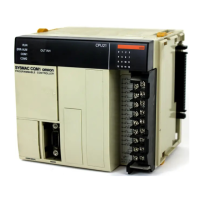169
Specifications Appendix A
Sensor Specifications
The following table lists combinations of typical sensors that can be used in combination with each sensor
module.
E3X-MA11
Note 1. Values in parentheses are possible if the E39-F1 Lens Unit is used.
2. The sensing distances of the E32T16 with slits are as follows:
0.5-mm wide slit: 450 mm with a minimum sensing object size of 0.2 mm dia.; 1.0-mm slit: 800 mm
with a minimum sensing object size of 0.3 mm dia.
3. The E32-T51 can be used continuously within a temperature range of –40
° to 130°C.
Item Sensing
method
Thru-beam model Side view
thru-beam
model
Heat-resistive
thru-beam
model
Screen thru-
beam model
Feature Long sensing
distance
Standard
sensing
distance
Flexible cable Long sensing
distance
Resisting
150°C
Sensing a
width of 10
mm
Model E32-T11L E32-TC200 E32-T11 E32-T14L E32-T51 E32-T16
Sensing distance
(standard sensing
object)
500 mm
(1,200 mm)
(see note 1)
(1.4 dia. mm
min. non-trans-
parent object)
270 mm
(2,000 mm)
(see note 1)
(1 dia. mm
min. non-
transparent
object)
240 mm
(1,300 mm)
(see note 1)
(1 dia. mm
min. non-
transparent
object)
130 mm (
1dia. mm min.
non-transpar-
ent object)
300 mm
(1.5 dia. mm
min. non-trans-
parent object)
1,000 mm
(see note 2)
(view: 10 mm
wide) (10 dia.
mm min. non-
transparent
object)
Minimum sensing
object (non-trans-
parent object)
0.2 dia. mm 0.3 dia. mm 0.4 dia. mm 0.2 dia. mm
(see note 2)
Ambient operating
temperature
–40° to 70°C with no icing –40° to 150°C
with no icing
(see note 3)
–40° to 70°C
with no icing
Ambient operating
humidity
35% to 85%
Permissible bending
radius
25 mm min. 4 mm min. 25 mm min. 35 mm min. 25 mm min.
Cable covering Black polyethylene Vinyl chloride Black polyeth-
ylene
Fluorocarbon
resin
Black polyeth-
ylene
Enclosure rating IEC IP67

